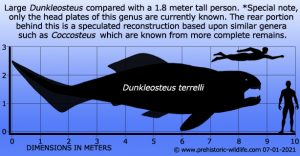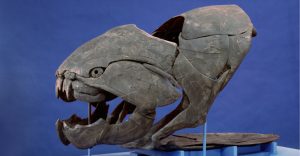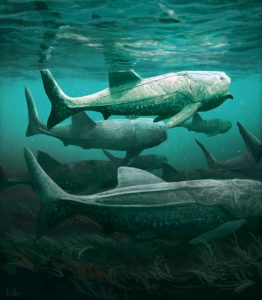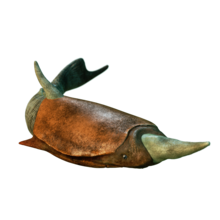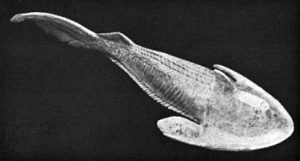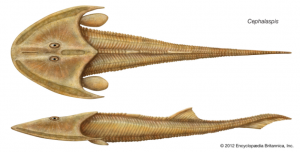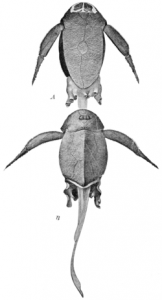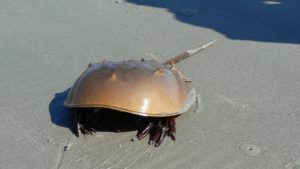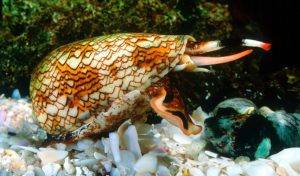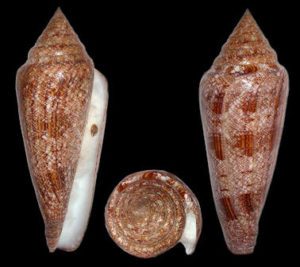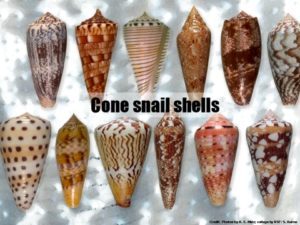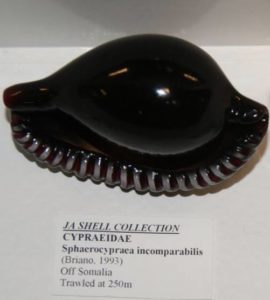Podcast: Play in new window | Download (Duration: 10:27 — 11.7MB)
Thanks to Micah for suggesting this week’s topic, the trilobite!
Further reading:
Stunning 3D images show anatomy of 500 million-year-old Cambrian trilobites entombed in volcanic ash
Strange Symmetries #06: Trilobite Tridents
A typical trilobite:
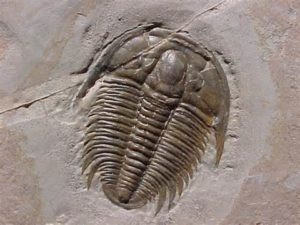
Isotelus rex, the largest trilobite ever found [photo from the first link above]:
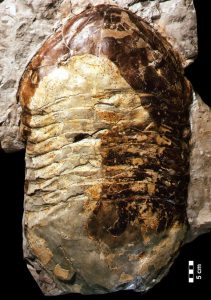
Walliserops showing off its trident [picture by TheFossilTrade – Own work, CC BY-SA 4.0, https://commons.wikimedia.org/w/index.php?curid=133758014]:
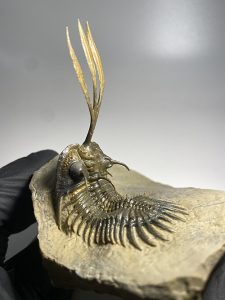
Another Walliserops individual with four prongs on its trident [photo by Daderot, CC0, via Wikimedia Commons]:
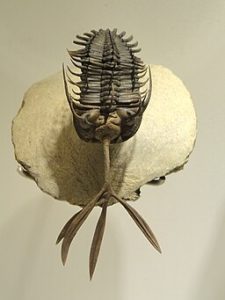
Show transcript:
Welcome to Strange Animals Podcast. I’m your host, Kate Shaw.
This week we’re going to learn about an ancient animal that was incredibly successful for millions of years, until it wasn’t. It’s a topic suggested by Micah: the trilobite.
Trilobites first appear in the fossil record in the Cambrian, about 520 million years ago. They evolved separately from other arthropods so early and left no living descendants, that they’re not actually very closely related to any animals alive today. They were arthropods, though, so they’re distantly related to all other arthropods, including insects, spiders, and crustaceans.
The word trilobite means “three lobes,” which describes its basic appearance. It had a head shield, often with elaborate spikes depending on the species, and a little tail shield. In between, its body was segmented like a pillbug’s or an armadillo’s, so that it could flex without cracking its exoskeleton. Its body was also divided into three lobes running from head to tail. Its head and tail were usually rounded so that the entire animal was roughly shaped like an oval, with the head part of the oval larger than the tail part. It had legs underneath that it used to crawl around on the sea floor, burrow into sand and mud, and swim. Some species could even roll up into a ball to protect its legs and softer underside, just like a pillbug.
Because trilobites existed for at least 270 million years, there were a lot of species. Scientists have identified about 22,000 different species so far, and there were undoubtedly thousands more that we don’t know about yet. Most are about the size of a big stag beetle although some were tinier. The largest trilobite found so far lived in what is now North America, and it grew over two feet long, or more than 70 centimeters, and was 15 inches wide, or 40 cm. It’s named Isotelus rex.
I. rex had 26 pairs of legs, possibly more, and prominent eyes on the head shield. Scientists think it lived in warm, shallow ocean water like most other trilobites did, where it burrowed in the bottom and ate small animals like worms. There were probably other species of trilobite that were even bigger, we just haven’t found specimens yet that are more than fragments.
Because trilobites molted their exoskeletons the way modern crustaceans and other animals still do, we have a whole lot of fossilized exoskeletons. Fossilized legs, antennae, and other body parts are much rarer, and preserved soft body parts are the rarest of all. We know that some trilobite species had gills on the legs, some had hairlike structures on the legs, and many had compound eyes. A specimen with preserved eggs inside was also found recently.
Some incredibly detailed trilobite fossils have been found in Morocco, including details like the mouth and digestive tract. The detail comes from volcanic ash that fell into shallow coastal water around half a billion years ago. The water cooled the ash enough that when it fell onto the trilobites living in the water, it didn’t burn them. It did suffocate them, though, since so much ash fell that the ocean was more ash than water.
The ash was soft and as fine as powder, and it covered the trilobites and protected their bodies from potential damage, while also preserving the body details as they fossilized over millions of years. The fossils were discovered in 2015, about 509 million years after the trilobites died, and are still being studied.
Two species of trilobite have been found at this Morocco site, and the team is using non-invasive technology to study the preserved insides in one exceptionally preserved specimen. Its entire digestive system is intact, probably because the poor trilobite ended up swallowing a lot of ash before it died. The ash kept the soft tissues from decomposing.
Some trilobites had spines growing from their head shields and even from the rest of the exoskeleton. Scientists think these may have helped protect the animals from being eaten, but they might also have helped them navigate more easily in the water without getting flipped over by currents. One genus of trilobite, Walliserops, even had a structure sticking out from the front of its head called a trident.
The trident grew forward and slightly upward from the head, then split into three prongs. Scientists aren’t sure what it was for, but suggest that it acted as a nose spike like some modern beetles have, which allowed trilobites to fight each other for resources or mates. The tridents weren’t completely symmetrical, and one individual has even been found with a four-pronged trident. (I guess you would call that a quadrent.) Some species had long tridents, some short, but there’s no evidence that only males or only females had them.
Electron microscopes and other modern imaging technology have allowed scientists to learn more about what the trilobite looked like when it was alive. This includes some hints about different species’ coloration and markings. Most trilobites had good vision and were probably as colorful as modern crustaceans. Some rare trilobite fossils show microscopic traces of spots and stripes. One species studied may have had a brown stripe that faded to white along the edges of the body.
All trilobites went extinct at the end of the Permian, about 250 million years ago, during the extinction event called the Great Dying. We talked about it in detail in episode 227 so I won’t go over its causes and effects again except to say that an estimated 95% of all marine animals went extinct during that event. The Great Dying ended the trilobite’s successful 270 million year run on this amazing planet.
When I was little, I found trilobites fascinating. They were so common for so long, and then they were gone. I’ve always wondered if some trilobites survived the Great Dying and were still alive in the deep sea. I’m not the only one who’s wondered that, so let’s talk a little more about why the trilobites went extinct and how some of them might have survived.
Almost all trilobites we know of lived in shallow coastal water. We have trilobite tracks of an ancient low tide shore, which tells us that at least some species could leave the water and venture onto land occasionally, possibly the first animals on earth to do so. Coastal water is well oxygenated and we know trilobites had trouble surviving anoxic events, when the water where they lived had much less oxygen than usual. Anoxic events are actually what led to the Great Dying, but it wasn’t the first time the world’s oceans became less oxygenated. It happened in earlier extinction events too during the Devonian, around 372 and 359 million years ago, and each time many species and genera of trilobites went extinct. The trilobite was already in decline when the Great Dying occurred, with only a handful of genera left, and the extinction event finished them off once and for all according to the fossil record.
But we do know of a few species of trilobite that were adapted to the deep sea. Deep-sea animals have to evolve to be tolerant of low-oxygen conditions. The deep sea is also very little known by humans. It’s possible, even if it’s unlikely, that deep-sea trilobites survived the Great Dying and that their descendants are still around, unknown to science.
One interesting note, and an ongoing mystery about trilobites, is that while we know they were arthropods, we don’t actually know which branch of the phylum Arthropoda they’re most related to. That’s because there are no ancestral versions of the trilobite that have ever been found. When they appear in the fossil record, they’re already recognizably trilobites. It’s possible that the ancestral forms didn’t have exoskeletons that were likely to fossilize, or that we just haven’t found the right fossil bed yet. Until we learn more, it’ll remain a mystery.
You can find Strange Animals Podcast at strangeanimalspodcast.blubrry.net. That’s blueberry without any E’s. If you have questions, comments, or suggestions for future episodes, email us at strangeanimalspodcast@gmail.com. We also have a Patreon at patreon.com/strangeanimalspodcast if you’d like to support us for as little as one dollar a month and get monthly bonus episodes.
Thanks for listening!
